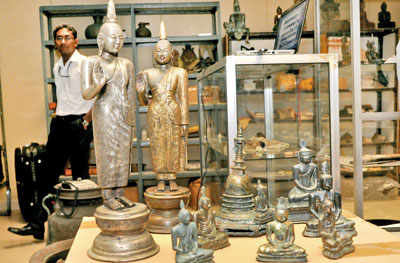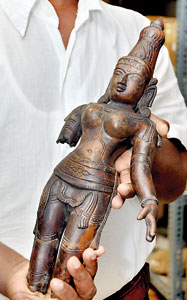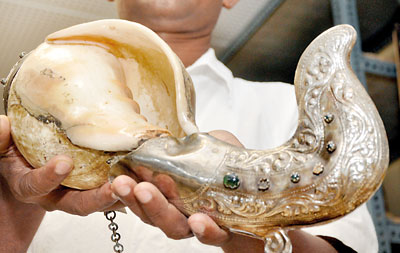News
Now they are getting away with moonstones
As the mass plunder of ancient artefacts continues unabated, authorities are at a loss to curb the epidemic.
Robbers have been known to crack open moonstones, or carved temple steps, in their quest for ancient treasure. But it takes greater planning, resources and audacity to make off with a complete ‘sandakadapahana’, as a group of plunderers did last week. Around 1.30 am on Tuesday, four men dressed in what looked like military garb, went to the Herath-halmillewa Raja Maha Vihara in Kebetigollewa.
A home-guard deployed there, woke up Ven. Dutuwewe Jinananda Thera, the Chief Incumbent, saying the men were soldiers heading towards a nearby camp. “I offered them plain tea,” Ven. Jinananda Thera told the Sunday Times via telephone. “But they wanted water and some chews of betel.” He gave them a jug of water, the betel tray and returned to bed.

The storeroom full of treasures: The many items confiscated by Customs. Pix by Indika Handuwala
Afterwards, more men had entered the premises. They gagged the home-guards and tied them to trees. They then chipped away at the base of the moonstone for two hours, and left with the slab around 3.30 am.
“I knew this would happen,” sighed Dr Siran Deraniyagala, a former Director of Archaeology. It is only six weeks since a moonstone smuggled to Britain from Sri Lanka many decades ago, was sold in London for £ 553,250 or nearly Rs 110 million.
Bonhams, the auction house, had set the pre-sale estimate between £ 20,000 and £ 30,000. However, as buyers in the room and on the telephone battled with one another to secure the piece, the price soared.
Dr Deraniyagala contends that the large sum the moonstone fetched- and the massive publicity it generated, will motivate pillagers to target temple steps in Sri Lanka. Until now, ‘sandakadapahan’ were not seen as lucrative commodities by the marauding gangs who hunt for valuables at Buddhist temples and Hindu shrines.
While some dig up archaeological sites for treasure such as ancient gemstones and jewelry, others steal items of worship like Buddha statues and sculptures of Hindu deities. Each theft is different, although there are basic similarities.
Sometimes, the cooperation of chief priests or custodians is solicited and obtained. Other times, it is straightforward robbery. The more remote the site, the easier it is. One or more people from the village are usually involved along with outsiders. In instances where religious rites are performed (to appease the gods), it is not unusual to find that the ‘kattadiya’ who conducts the ceremony is involved in several similar robberies.
It happens every month. On June 2, for instance, four Hindu shrines in Batticaloa and Ampara were plundered. From one of these temples alone, Kurukkalmadam in Batticaloa, robbers escaped with 19 bronze statues and 20 gold sovereigns. It is evident that there is a strong market for these objects. But who buys them? Where do they end up?
 |
 |
Local antique shops everywhere vend ancient statues and artefacts, along with replicas. There are also many other articles of historic value on sale. It is not possible for anyone with an untrained eye to gauge whether or not these items are authentic, or where they had been procured from.
Trading in antiques within Sri Lanka is permitted; so is the possession of antiques. The theft or robbery of antiques is not. The enormous quantity of statues and other artefacts on sale and display in local shops raises questions about their origin. The Archaeological Dept has made little effort to study whether antiques at such establishments have been legitimately obtained. They are overwhelmed enough by the spiraling numbers of thefts, robberies and vandalism.
“They are not all replicas at these shops and establishments,” said a keen observer of artefacts. “Look at the way they are made. Some of them still have the (original) paint on them.” The Dept does have its own problems. “There is no way for the Archaeological Dept to determine whether or not an artefact was acquired illegally, because there is no registry,” said Kavan Ratnatunga, a coin collector. “The Dept cannot tell you whether an item has come down from generation to generation, before it was sold to someone else, or whether it was found recently.”
A law envisaging the creation of such a registry was enacted, but the Dept found it impossible to implement. “I think they tried to do it in Matale, where they went house to house for the purpose of creating records, but they realizsed that it couldn’t be done,” Mr. Ratnatunga said.
Sri Lanka’s heritage on sale abroad, at a price
It is illegal to export any artefact that predates March 2, 1915, as it is deemed to be cultural property belonging to the State. However, an antique may be taken out on a licence granted by the Director of Archaeology. It is questionable whether all the items publicly on sale abroad, were exported with the Dept’s consent.
Christie’s is Britain’s best known auction house. Last week, it had a mixed bag of Sri Lankan pieces on offer, including two Anuradhapura period Buddha statues. One was priced at between $ 9,188 and $ 11,813, while the other’s pre-sale price was estimated to be between $ 18,376 and $ 21,002. Both statues are in France, and are said to belong to a private collection.
The Buddha Gallery is a website run by a United States-based antiques dealer. Among the Sri Lankan statues advertised on it is a, “Remarkable and large Sri Lanka 16th/17thC Bronze Buddha from the early Kandy period.” The vendors says that, based on the casting and feel of the piece, he believes it may be much earlier.
The piece retains some of its original polychrome, he says, which creates a beautiful and very rare patina. It is this polychrome that the observer earlier quoted, also alluded to. The statue is solid cast and weighs about 13.5 pounds. It is 11 inches tall and 7.5 inches wide at the knee.
“In 20 years,” the dealer asserts, “I’ve never seen another like it.” He does not say how he had acquired it. Where items have been obtained from old family or private collections, however, he does declare it.
This dealer even has for sale a three-and-a-quarter inch tall, 10th to 14th Century Sri Lankan Buddha statue made of lead alloy. But his Burmese, Thai and Chinese collection far outnumber his Sri Lankan one.
In 2009, the Customs Dept notified the Dept of Archaeology that The Buddha Gallery was selling Sri Lankan statues. Samantha Gunasekara, Director of the Customs Biodiversity Unit, said he discovered this after his division stopped an attempt to smuggle out 74 Sri Lankan antiques via an international courier service.
A Swedish national and an American national were involved in the effort, Mr. Gunasekara said, and were penalised with spells at the Negombo Remand Prison and fines. Both have since left the country. The Swede, Robert Ulvenkrantz, when contacted via telephone by the Sunday Times, insisted that the goods had all been replicas he had bought from shops in Negombo.
Mr. Gunasekara admitted that the Customs Dept faced the challenge of distinguishing replicas from the real thing. “We don’t have the equipment,” he said. So, Customs takes in artefacts on suspicion, that they might be antiques, and has them tested for authenticity later.
In a storeroom near his bureau, Mr. Gunasekara points to many items confiscated by Customs. There are turtle and conch shells, spiders, beetles and butterflies. There are also beautiful statues, coins, boxes, containers, daggers and clothing of historic value.
It is clear to experts that the moonstone stolen from Kebetigollewa is intended for the international market. Who will take it out and how?
Follow @timesonlinelk
comments powered by Disqus

